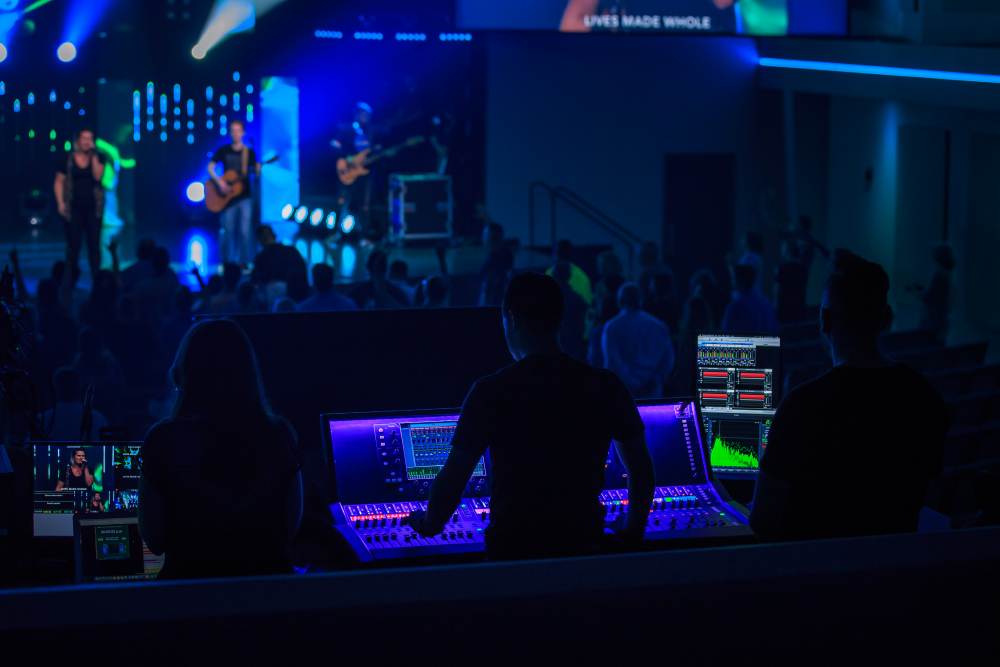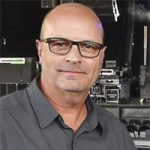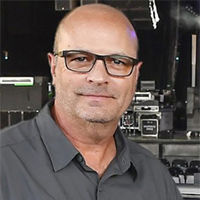Great worship music paired with an audio mix that supports and uplifts the musicians is entirely possible if both parties are willing and excited to work on it together.
I’ll start by saying that this piece is written from the viewpoint of an audio mixer, not a musician on stage, so please don’t think I’m trying to tell musicians how to play their instruments. I’m simply passing on some tips and tricks that many years behind a console have taught me, and I feel musicians would benefit from (and would like to know) these things so that they can sound their best in the house mix.
With that in mind, here are five ideas to consider:
One. Drums should be the foundation, not something the mix engineer is fighting. In a lot of modern worship music, the musicality, power and volume of the mix rivals pop and rock concerts. Many worshippers expect the mix to sound big and punchy, and I think most of us can agree that it all starts with the drums.
As a mix engineer who has mixed both rock concerts and worship music, here’s a technique or “style” of drumming that I feel produces the best result in the sound system and church auditorium. I like to think of it as a “volume pyramid”, where certain parts of the drum kit are struck with more velocity, while others are treated with a little tenderness to keep from overpowering the mix out front.
It all starts with a solidly struck bass drum and snare. Dynamics are great, and certain parts of the song require bringing the volume down acoustically, so the eventual swell is more dramatic, but sound engineers absolutely love when the quietest notes and loudest notes are not all that far apart in regard to decibels. When the kick and snare are locked in, laying down the foundation of the song with consistency and authority, the sound engineers can build a wall of sound on top of that base. When the mix engineer is struggling to keep the kick drum in the mix and then it suddenly comes slamming through, it’s distracting and difficult, and it crumbles the solid core of your mix.
This is important and something I hope can be said without being offensive to talented musicians: Having a wide dynamic range as a drummer in a modern pop, rock or worship band is not unappreciated, but it adds another layer of complexity to the mix engineer’s job, and I believe most engineers would agree that consistency is desired over dynamics – and it all starts with the kick and snare.
Toms also sound best in the sound system when struck with a consistent velocity compared with “whisper quiet to thunderous” extremes. Not only does it help the noise gates to open and close as expected, but it also requires less EQ and compression to keep them solidly in the mix.
If the kick and snare are the cornerstones of the mix and the toms are the next layer up, the hi-hat and ride are next in importance, and should be played in a similar fashion, with quiet parts not too quiet, and a determination to shy away from loud bashing of open high hats and playing ride cymbals like crashes. And speaking of crash cymbals, a similar “velocity window” between quiet accents and loud statements is appreciated at the mix console.
Two. Watch the stage volume of guitars, and if possible, use an amp simulator. Before amp simulators like Kempers, Fractals and Strymon Iridiums became so popular, it was often necessary to crank up the guitar amp to achieve the overdriven sound so many guitarists are after. That approach can work in a studio or arena, but in smaller auditoriums, a ferocious guitar volume emanating from the stage can cause multiple problems – not only for the mix engineer but also for fellow musicians on stage as well as the first five rows of worshipers!
An awesome guitar sound with controlled volume on stage is very much appreciated by audio engineers. Guitar amp modelers/simulators are a great way to achieve this. Prices range from a few hundred to several thousand dollars, so it’s not always feasible to add one to a guitar rig, but if you consider the money saved at the onset of purchasing gear by going with a simulator versus an amp/cabinet combo, it might be the best financial decision. Couple this piece of gear with a footswitch to alternate between tones and FX presets, along with the willingness to put the time in programming, and the result can be an amazing and versatile guitar sound.
One of the most overlooked, yet highly appreciated aspect of building great guitar sounds is volume balancing between presets. Clean and wet or dirty and overdriven, it’s wonderful when the mix engineer doesn’t have to chase level fluctuations as a guitarist bounces between sounds on a pedalboard. I’ve even had guitar players ask me if I’d appreciate a small volume boost for lead solos. If the boost is reasonable and fits within the other instrumentation, the answer is “Yes” – and thanks for the help!
The same discipline applies to bass guitar, keyboards and support tracks coming from a computer multitrack session. There can be a lot for the mix engineer to manage if the song structure has complicated instrumentation and vocal layering, so keeping guitar, keyboard and track levels level balanced goes a long way to ensuring great sounding house and monitor mixes. Dynamics are great, but excessive volume shifts are not.
Three. Know “when to say when” with guitar FX. Worship music is often emotional and passionate, and a “wet” house mix with plenty of reverb, delay and chorus can help elevate the spirit of the song.
A portion of the carefully utilized FX is a responsibility of the mix engineer, but some of the musicians in the band have effects of their own within their instrument systems. Guitar rigs, keyboards and backing tracks from a multitrack session “sprinkled” with tasteful effects can be wonderful, but if they end up “swimming” in reverb, delay and chorus, it makes it tough on the mix engineer to deliver a clean, tight mix. It’s a fine line, and my best advice is to err on the side of “less is more” and let the mix engineers add what’s missing.
One strategy I’ve come to utilize is to request separate “sends” from the guitar rig to provide a clean center channel along with a left/right FX pair to the house and monitor mixes. It gives the engineers an option to clean things up if they get a little too wet or reduce the center clean channel and ride the left/right FX pair up for a wetter result. This type of routing is one of the benefits of guitar simulators/modelers but can also be achieved with standard guitar amp/cabinet combinations using FX pedals and some creative programming and routing.
Four. Vocalists: sing out, sing close and sing consistently. Vocals are the key instrument when performing and joining in worship. They lift up the words that honor God and invite the congregation to become part of the experience.
Dynamic vocals (regarding “ups and downs” in volume and intensity) are one of the ways emotions can be expressed with the voice, but in keeping with the theme of these tips, moderating the swells and dips are helpful to the audio mixers. Most singers understand the wide range of tonal shifts and volume fluctuations that comes from singing with “lips against the windscreen” of the mic versus pulling the mic away six to twelve inches or more.

Singers who are part of very loud bands – on a small stage with a drum kit and guitar amps very close to the vocal mics – they may already have adopted the technique of staying “on the mic.” However, for those who aren’t familiar, here’s how it works: with your lips right up against the windscreen and only departing a couple inches from time to time, you may discover it results in full midrange and low-end tonality and less bleed from the things around you. Your head acts as a shield between your vocal mic and the ambient noise around you, and your vocal level stays much more consistent in your ear monitors, wedge speakers and the house mix.
In music with a lot of space instrumentally, there are times to move the mic more dramatically close to and away from your mouth for dynamics, but a good general rule to maintain consistency in vocal tonality and level is to stay on the mic and “sing out “with a strong voice. The problems of ambient bleed are multiplied with the number of open mics on stage. With six singers standing directly in front of a loud drum kit, singing a foot away from their mics, it becomes extremely challenging for the audio engineers to construct balanced in-ear monitor mixes and the house mix.
Five. Request a balanced monitor mix and “leave a space – fill a space” to allow each other to shine. Monitor engineers are on stage with the musicians to blend the entire band together in each member’s monitors (whether in-ear or wedges) to create a natural, balanced mix that helps everyone play and sing their best.
Some musicians request a more unbalanced mix where their instrument or voice is much louder than the rest of the band and maybe one or two instruments are brought up in level to assist in providing time (such as the hi-hat),or pitch (possibly a piano or guitar). If this helps certain musicians perform their best, I don’t knock it, but I like to build monitor mixes and work with musicians to first try a more balanced mix of every instrument and vocal on stage. I believe it keeps the band connected and helps each musician to appreciate what every other member is contributing to the song and the worship experience.
As an audio mixer, I appreciate musical arrangements where space is left in the verses, bridges, and even the choruses for certain instruments and vocals to be highlighted with a short riff or run of notes that help create movement within the song. Not only can the arrangement create this environment, but as each member of the band listens to the others around them, they can pick spots in the song where space has been created and a quick musical or vocal “moment” can be inserted to add character to a song.
If the piano, guitars, keys and vocals (and even the drums) take turns accenting throughout the song, the entire song is elevated and more dynamic, compared to the entire band filling every space with musical and vocal “data” that can become cluttered sonically and spatially. Leave spaces in your musical arrangements and occasionally fill a space with a creative and expressive riff to add to the worship.
Many sound engineers are musicians, and some musicians are also accomplished audio mixers and engineers. I believe we can all agree that musicians and the audio team can work together to provide a great result that invites and creates a worshipful musical experience. I hope these tips and tricks from the “wish list of an audio engineer” help musicians understand what sound engineers desire to help each musician and the collective worship band shine in the sound system.




















